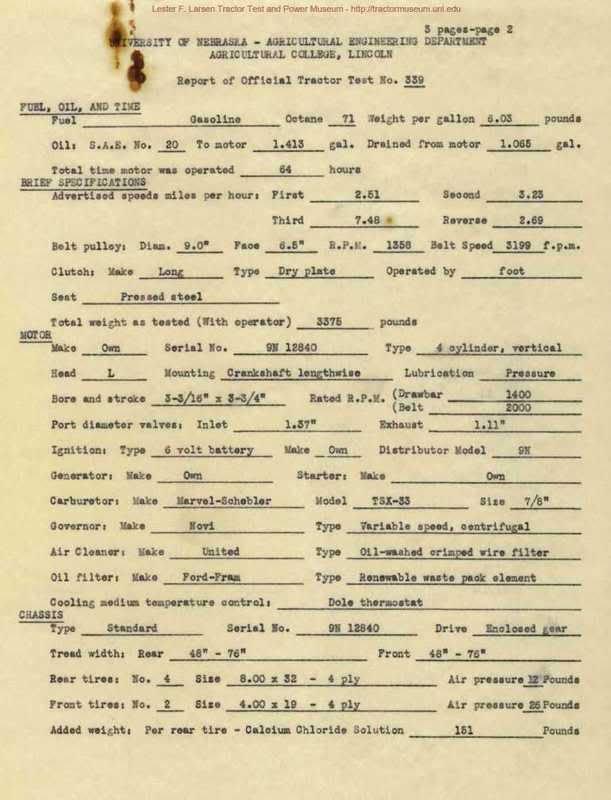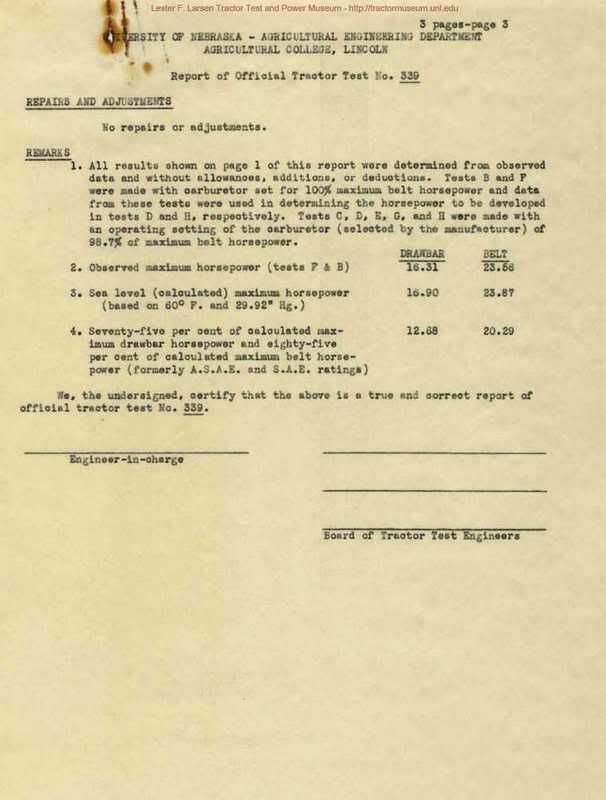Subject: Official Results Tractor Test 339
[Back] [Return to Top of Forum]
| Farmer Dan |
Posted 04-19-2008 at 22:56:03 [URL] [DELETE]
[Reply] [Email]  Missed this on earlier when so Ed didn't get to post this one. This is page 1 | |
|---|---|---|
| Farmer Dan |
Posted 04-19-2008 at 22:56:43 [URL] [DELETE]
[Reply] [No Email]  This is page 2 | |
| Gary__Sarge |
Posted 04-20-2008 at 21:46:18 [URL] [DELETE]
[Reply] [Email] Hey Farmer Dan
Gee, we get 87 octane now and it only cost about $3.50 +/- more :( It is surprising what they use to do way back when :)>!!!
Gary & Sarge
| |
| Jon Rhee (RI) |
Posted 04-21-2008 at 13:34:01 [URL] [DELETE]
[Reply] [Email] I saw that too. I wonder what the increase in octane does to the horsepower, if anything. I also noted that every crappy riding lawnmower made today has a 16 hp engine in it, albeit they make 16 HP at 4000 rpm....lol. | |
| Kent |
Posted 05-02-2008 at 15:37:50 [URL] [DELETE]
[Reply] [Email] Ah, the miracle of a low compression engine...it could run with no problem on 71 (!) octane fuel. I doubt there's any appreciable difference in HP with today's higher octane fuel. In fact, there might be a detrimental effect if using 93 (or higher) fuel. Octance number is just a measure of resistance to "knock" or premature ignition of the fuel. When you compress a gas (or in our case an actual gasoline/air mixture), it gets hot. The more you compress, the hotter it gets. With a low octane number, it could get hot enough to ignite without any spark from the plug. If it does that, it almost always not at the right time (or the same time that the plug would ignite it), so a pressure blast hits the top of the piston and side walls of the cylinder, producing "knock". Today's engines are much higher compression than the N's 6 or 6.5 to 1 ratio (can't remember which). They'd probably almost all 'knock' on that 71 octane gas, especially any of the high-performance engines with compression ratios upwards of twice that of the N. I think there's a practical limit of compression ratio (just the ratio of the volume of the cylinder when the piston is at the low point of its stroke (BDC) compared to the volume of the cylinder when the piston is at the top of its stroke (TDC). Seems like the limit is around 13.5:1. With these high ratios, you compress the mixture even more, so when it ignites and burns, it expands greatly and pushes against the piston with more force. This turns the crankshaft with more force, and the result is more HP. But the flip side of more compression is more heat, and more chance of predetonation, hence the requirement of high performance engines to have 93 octane fuel. Most cars run fine on the 87 (higher altitude) or 89 'regular'. We don't have lead anymore for valve seat lube and anti-knock properties, so they add chemicals to increase the octane number. A high octane gas is actually harder to ignite than a low octane gas, since it's designed to be more resistant to ignition (to avoid preignition). Thus, you might have a drop in performance with 93 (or sometimes 100 octane gas ocassionally available) gas in the old N that started life as a 6:1 compression ratio and, with years of wear, is probably something even less than that now. | |
| Farmer Dan |
Posted 04-19-2008 at 22:57:32 [URL] [DELETE]
[Reply] [No Email]  this is page 3 the last page |
[Back] [Return to Top of Forum]